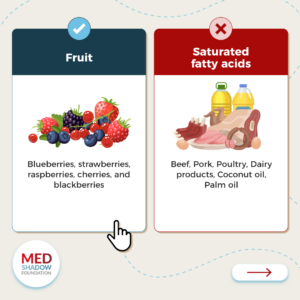When you suffer from chronic pain, what to eat may be the furthest thing from your mind. Your day is filled with discomfort, so preparing a meal doesn’t sound like much fun. However, the foods that you put into your body can go a long way in treating nearly any condition, even chronic pain.
With 20% of the world’s population enduring chronic pain each day, it is important to understand that food is medicine. What we choose to eat each day can improve or worsen our symptoms. Food isn’t just your body’s source of fuel, but also serves as the primary way to deliver nutrients to the many intricate systems required for you to function.
While you may have multiple pain management strategies, what you eat should be high on your list of priorities. Working in conjunction with exercise, medication, supplements, and alternative health practices, food can make a big change in how you feel each day.
MedShadow’s Medical Advisory board member and registered dietician, Alison Acerra, MS, RDN, has four nutrition strategies you can consider as treatments to your chronic pain.
“Chronic pain often stems from inflammation and oxidative stress in the body,” says Acerra. “Inflammation is the body’s response to injury. Oxidative stress happens when too many unstable molecules called free radicals in the body, which can cause damage to cells and lead to various health issues over time. The good news is, we know there is a connection between what we eat and inflammation and oxidative stress.”
1. Choose an Anti-Inflammatory Diet
When considering foods overall, Acerra encourages those with chronic pain to consider the anti-inflammatory diet.
“It is less of a diet and more of an eating pattern that includes foods that can reduce chronic inflammation,” she says. This eating style includes “ample amounts of fruits and vegetables, healthy oils, fatty fish, nuts, and seeds” while limiting and “being mindful of red meat, added sugars and processed foods
For anti-inflammatory recipe ideas, MedShadow offers diet tips here.
2. Focus on Anthocyanin-Rich Foods

Don’t let a big, strange word throw you off.
“Anthocyanins are a class of antioxidants that combat inflammation directly, while reducing oxidative stress by inhibiting the production of inflammatory compounds,” says Acerra. She notes that, when selective fruits and vegetables specifically, those suffering from chronic pain should be aware of the anthocyanins included in each. “These potent antioxidants also neutralize harmful radicals that can contribute to oxidative stress.”
Where does one find “anthocyanin-rich foods” when perusing the produce aisle?
“Food sources include red, purple, and blue fruits and veggies,” says Acerra, who recommends blueberries, strawberries, blackberries, cherries, red grapes, red cabbage, eggplant, and radishes to be incorporated into your daily eating routine.
3. Include Curcumin In Your Diet
Curcurmin is the primary, active component of turmeric. Not only does curcumin give the spice its yellow color, but it also has anti-inflammatory properties making it ideal to treat a number of health conditions.
Acerra says these compounds can “reduce pain and increase range of movement.” While studied largely in treatments of osteoarthritis, these same anti-inflammatory benefits can aid those suffering with chronic pain, too.
4. Add Green Tea
Acerra says that studies have shown green tea extract to reduce pain and increase knee joint function in adults, especially for those with osteoarthritis. These same key benefits can also assist those with inflammatory causes of chronic pain.
Acerra says another long and strange-sounding word may be the key to this phenomenon: Epigallocatechin (ECEG). Thankfully, you don’t need to say it three times fast for it to work! Instead, this powerful compound is again an antioxidant with anti-inflammatory properties.
5. Limit or Avoid Gluten

“Gluten can contribute to inflammation,” says Acerra. She notes it is especially important to reduce the amounts of gluten for those that have a sensitivity or intolerance to gluten, a trait that is increasingly common in individuals.
“Gluten is a protein found in wheat, barley, and rye, and their derivatives,” says Acerra. “Even those without Celiac, an autoimmune disorder that requires the elimination of gluten, can experience non-Celiac gluten sensitivity, in which eating gluten can cause various symptoms including inflammation.”
Changes to Your Diet Can Help
While eating an anti-inflammatory diet alone cannot likely completely eliminate chronic pain, it can be helpful when used in conjunction with other lifestyle modifications. Acerra encourages sufferers to also monitor their emotional wellbeing, as the pain from emotionally traumatic events can often manifest as physical pain.
Our bodies are completely interconnected, with emotions impacting physical health, foods weighing in on pain, and lifestyle choices such as exercise greatly affecting our health. While food is one crucial element to lessen pain, our interrelated systems truly work together to function and must be viewed as a whole.
Mental health plays another important role in a body’s overall wellbeing.






